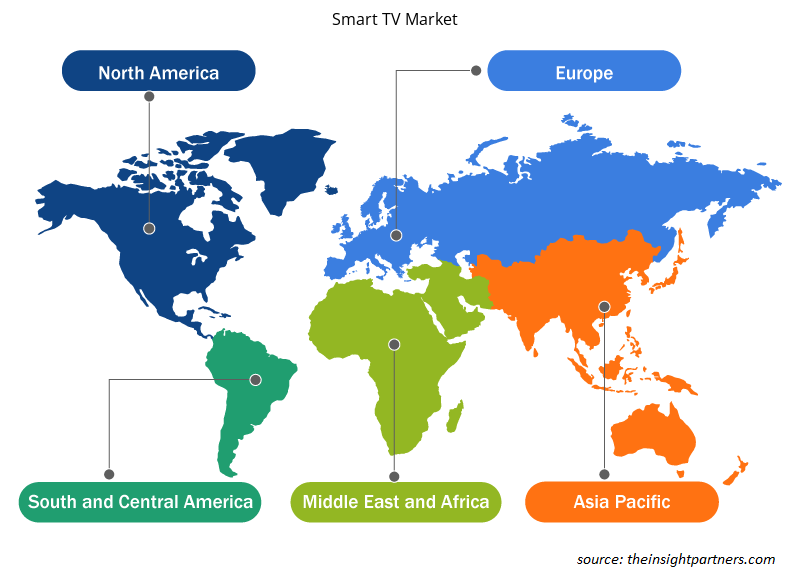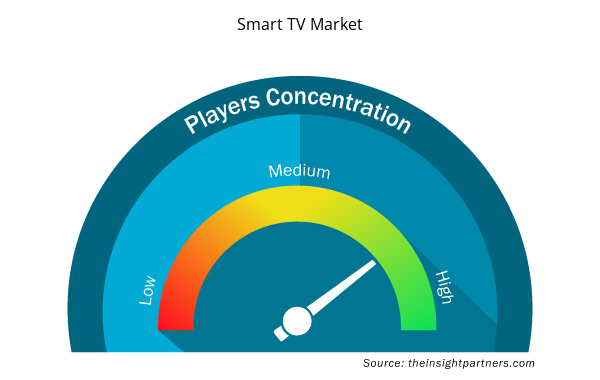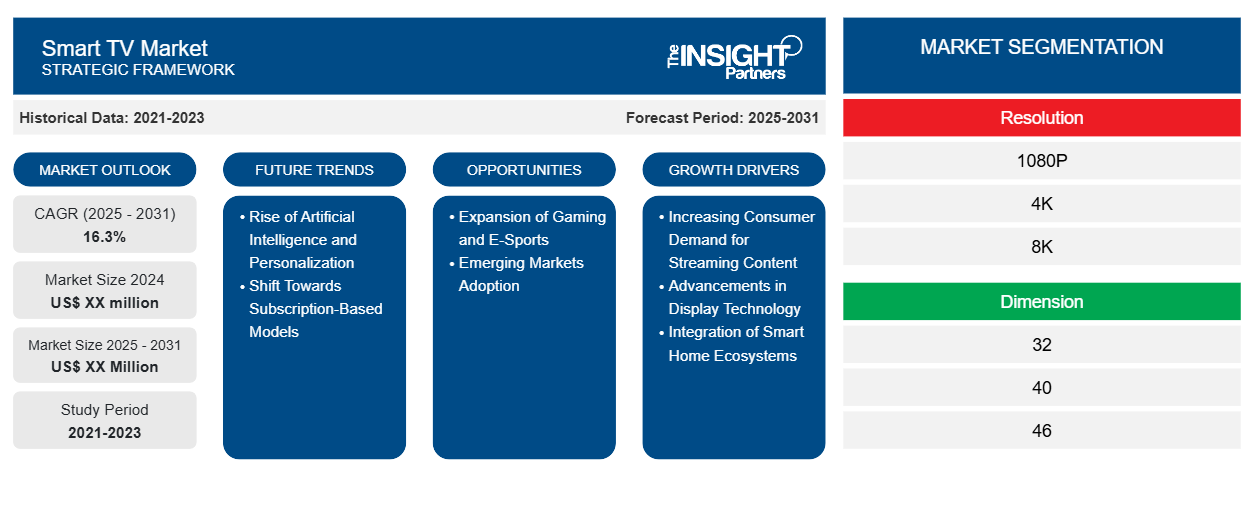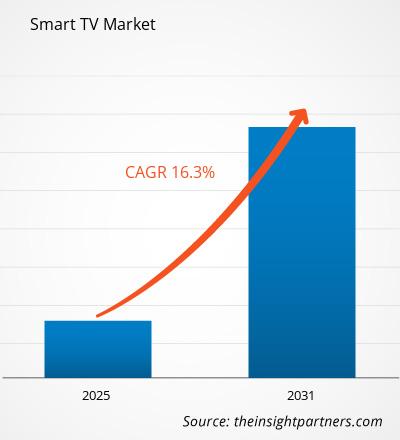Si prevede che il mercato delle Smart TV registrerà un CAGR del 16,3% dal 2024 al 2031, con una dimensione di mercato in espansione da XX milioni di dollari nel 2024 a XX milioni di dollari entro il 2031.
Il report è segmentato per Risoluzione (1080P, 4K, 8K, Altri), Dimensione (32, 40, 46, 55, 75 e oltre), Gamma dinamica (Standard, HDR), Applicazione (Residenziale, Commerciale). L'analisi globale è ulteriormente suddivisa a livello regionale e nei principali paesi. Il report offre il valore in USD per l'analisi e i segmenti di cui sopra
Scopo del rapporto
Il report Smart TV Market di The Insight Partners mira a descrivere il panorama attuale e la crescita futura, i principali fattori trainanti, le sfide e le opportunità. Ciò fornirà spunti a vari stakeholder aziendali, come:
- Fornitori/produttori di tecnologia: per comprendere le dinamiche di mercato in evoluzione e conoscere le potenziali opportunità di crescita, consentendo loro di prendere decisioni strategiche informate.
- Investitori: condurre un'analisi completa delle tendenze in merito al tasso di crescita del mercato, alle proiezioni finanziarie del mercato e alle opportunità esistenti lungo la catena del valore.
- Enti di regolamentazione: regolamentano le politiche e le attività di controllo sul mercato allo scopo di ridurre al minimo gli abusi, preservare la fiducia degli investitori e sostenere l'integrità e la stabilità del mercato.
Segmentazione del mercato delle Smart TV
Risoluzione
- Risoluzione 1080P
- 4K
- 8K
- Altri
Dimensione
- 32
- 40
- 46
- 55
- 75 e oltre
Gamma dinamica
- Standard
- HDR
Applicazione
- Residenziale
- Commerciale
Personalizza questo report in base alle tue esigenze
Riceverai la personalizzazione gratuita di qualsiasi report, comprese parti di questo report, o analisi a livello nazionale, pacchetto dati Excel, oltre a usufruire di grandi offerte e sconti per start-up e università
- Scopri le principali tendenze di mercato in questo rapporto.Questo campione GRATUITO includerà analisi di dati che spaziano dalle tendenze di mercato alle stime e alle previsioni.
Driver di crescita del mercato delle Smart TV
- Domanda crescente dei consumatori per contenuti in streaming: la crescente popolarità di servizi di streaming come Netflix, Hulu e Amazon Prime Video è un fattore determinante nel mercato delle smart TV. I consumatori sono sempre più alla ricerca di dispositivi che forniscano un accesso senza interruzioni a una varietà di contenuti online, tra cui film, programmi TV e sport in diretta. Le smart TV, dotate di app integrate e interfacce intuitive, soddisfano questa domanda offrendo funzionalità di streaming diretto. Man mano che sempre più famiglie si allontanano dagli abbonamenti via cavo tradizionali, il desiderio di smart TV che migliorino le esperienze di visione continua a crescere, incrementando le vendite di mercato.
- Progressi nella tecnologia di visualizzazione: i continui progressi nella tecnologia di visualizzazione, come 4K, OLED e QLED, stanno spingendo in avanti il mercato delle smart TV. Queste tecnologie migliorano la qualità delle immagini, offrendo ai consumatori immagini più nitide, colori vivaci e contrasto migliorato. Man mano che i produttori innovano e introducono nuove funzionalità, i consumatori sono sempre più attratti dalle smart TV ad alte prestazioni che offrono esperienze di visione superiori. Inoltre, la crescente disponibilità di contenuti ad alta definizione supporta l'adozione di tecnologie di visualizzazione avanzate, stimolando ulteriormente la domanda di smart TV sul mercato.
- Integrazione degli ecosistemi Smart Home: la crescente tendenza all'automazione della casa intelligente sta influenzando in modo significativo il mercato delle smart TV. I consumatori sono alla ricerca di dispositivi che possano integrarsi perfettamente con i loro sistemi smart home esistenti, come assistenti vocali (ad esempio, Amazon Alexa, Google Assistant) e prodotti di automazione domestica. Le smart TV che offrono compatibilità con vari dispositivi smart home offrono maggiore praticità e migliorano l'esperienza utente. Con l'evoluzione del mercato, la capacità di controllare le funzioni smart home tramite smart TV sta diventando una caratteristica essenziale, guidando l'interesse dei consumatori e aumentando la crescita del mercato.
Tendenze future del mercato delle Smart TV
- Ascesa dell'intelligenza artificiale e della personalizzazione: l'integrazione dell'intelligenza artificiale (IA) nelle smart TV sta diventando una tendenza importante, migliorando l'esperienza utente attraverso raccomandazioni di contenuti personalizzati e interfacce più intelligenti. Gli algoritmi di IA analizzano le abitudini di visione e le preferenze per suggerire programmi, film e applicazioni pertinenti, rendendo più facile per gli utenti scoprire nuovi contenuti. Man mano che le smart TV diventano più intuitive e reattive alle preferenze individuali, si prevede che questa tendenza modellerà le aspettative dei consumatori e guiderà ulteriori innovazioni nel mercato delle smart TV.
- Spostamento verso modelli basati su abbonamento: c'è una tendenza crescente verso modelli basati su abbonamento per la distribuzione di contenuti su smart TV. Molti consumatori preferiscono la flessibilità di abbonarsi a vari servizi di streaming piuttosto che impegnarsi in pacchetti via cavo tradizionali. Questo spostamento sta portando all'emergere di servizi di abbonamento in bundle, dove i consumatori possono accedere a più piattaforme tramite un singolo pacchetto. Man mano che questa tendenza prende piede, è probabile che i produttori di smart TV esplorino partnership con servizi di streaming per offrire bundle esclusivi, migliorando la proposta di valore complessiva per i consumatori e guidando le vendite di smart TV.
Opportunità di mercato della Smart TV
- Espansione di giochi ed e-sport: il fiorente settore dei giochi presenta un'opportunità redditizia per il mercato delle smart TV. Con l'ascesa dei giochi online e degli e-sport, i consumatori sono sempre più alla ricerca di smart TV che offrano frequenze di aggiornamento elevate, bassa latenza e grafica immersiva. I produttori possono sfruttare questa tendenza progettando smart TV specificamente ottimizzate per le esperienze di gioco, dotate di modalità di gioco dedicate e compatibilità con le console di gioco più diffuse. Prendendo di mira la fascia demografica dei giocatori, le aziende possono espandere la propria portata di mercato e aumentare le vendite in questo segmento in crescita.
- Adozione nei mercati emergenti: l'espansione delle smart TV nei mercati emergenti rappresenta un'importante opportunità di crescita. Con l'aumento del reddito disponibile e della penetrazione di Internet in regioni come Asia-Pacifico, Africa e America Latina, sempre più consumatori cercano di aggiornare i propri sistemi di intrattenimento. Le aziende possono adattare le proprie strategie di marketing e offerte di prodotti per soddisfare le esigenze e le preferenze uniche di questi mercati, ad esempio offrendo opzioni di smart TV accessibili con contenuti localizzati. Questa attenzione strategica sui mercati emergenti può guidare una crescita sostanziale delle vendite e migliorare la presenza del marchio a livello globale.
Approfondimenti regionali sul mercato delle Smart TV
Le tendenze regionali e i fattori che influenzano il mercato delle Smart TV durante il periodo di previsione sono stati ampiamente spiegati dagli analisti di Insight Partners. Questa sezione discute anche i segmenti e la geografia del mercato delle Smart TV in Nord America, Europa, Asia Pacifico, Medio Oriente e Africa e Sud e Centro America.

- Ottieni i dati specifici regionali per il mercato delle Smart TV
Ambito del rapporto sul mercato della Smart TV
| Attributo del report | Dettagli |
|---|---|
| Dimensioni del mercato nel 2024 | XX milioni di dollari USA |
| Dimensioni del mercato entro il 2031 | XX milioni di dollari USA |
| CAGR globale (2025 - 2031) | 16,3% |
| Dati storici | 2021-2023 |
| Periodo di previsione | 2025-2031 |
| Segmenti coperti | Per risoluzione
|
| Regioni e Paesi coperti | America del Nord
|
| Leader di mercato e profili aziendali chiave |
|
Densità dei player del mercato della Smart TV: comprendere il suo impatto sulle dinamiche aziendali
Il mercato delle Smart TV sta crescendo rapidamente, spinto dalla crescente domanda degli utenti finali dovuta a fattori quali l'evoluzione delle preferenze dei consumatori, i progressi tecnologici e una maggiore consapevolezza dei vantaggi del prodotto. Con l'aumento della domanda, le aziende stanno ampliando le loro offerte, innovando per soddisfare le esigenze dei consumatori e capitalizzando sulle tendenze emergenti, il che alimenta ulteriormente la crescita del mercato.
La densità degli operatori di mercato si riferisce alla distribuzione di aziende o società che operano in un particolare mercato o settore. Indica quanti concorrenti (operatori di mercato) sono presenti in un dato spazio di mercato in relazione alle sue dimensioni o al valore di mercato totale.
Le principali aziende che operano nel mercato delle Smart TV sono:
- Apple Inc
- Hitachi Ltd
- Haier Inc
- Koninklijke Philips NV
- Elettronica LG
- TCL
Disclaimer : le aziende elencate sopra non sono classificate secondo un ordine particolare.

- Ottieni una panoramica dei principali attori del mercato delle Smart TV
Punti di forza chiave
- Copertura completa: il rapporto esamina in modo completo i prodotti, i servizi, le tipologie e gli utenti finali del mercato delle Smart TV, offrendo una panoramica olistica.
- Analisi degli esperti: il rapporto è compilato sulla base della conoscenza approfondita di esperti e analisti del settore.
- Informazioni aggiornate: il rapporto garantisce la pertinenza aziendale grazie alla copertura di informazioni recenti e tendenze nei dati.
- Opzioni di personalizzazione: questo report può essere personalizzato per soddisfare le esigenze specifiche del cliente e adattarsi in modo appropriato alle strategie aziendali.
Il rapporto di ricerca sul mercato delle Smart TV può quindi aiutare a guidare il percorso di decodifica e comprensione dello scenario del settore e delle prospettive di crescita. Sebbene possano esserci alcune preoccupazioni valide, i vantaggi complessivi di questo rapporto tendono a superare gli svantaggi.
- Analisi storica (2 anni), anno base, previsione (7 anni) con CAGR
- Analisi PEST e SWOT
- Valore/volume delle dimensioni del mercato - Globale, regionale, nazionale
- Industria e panorama competitivo
- Set di dati Excel


- Emergency Department Information System (EDIS) Market
- Vaginal Specula Market
- Small Molecule Drug Discovery Market
- Advanced Planning and Scheduling Software Market
- Embolization Devices Market
- Passport Reader Market
- Microplate Reader Market
- Saudi Arabia Drywall Panels Market
- Broth Market
- Railway Braking System Market

Report Coverage
Revenue forecast, Company Analysis, Industry landscape, Growth factors, and Trends

Segment Covered
This text is related
to segments covered.

Regional Scope
North America, Europe, Asia Pacific, Middle East & Africa, South & Central America

Country Scope
This text is related
to country scope.
Domande frequenti
The report can be delivered in PDF/PPT format; we can also share excel dataset based on the request
Some of the customization options available based on the request are an additional 3-5 company profiles and country-specific analysis of 3-5 countries of your choice. Customizations are to be requested/discussed before making final order confirmation# as our team would review the same and check the feasibility
Growth of over-the-top (OTT) services and integration of smart features are the major factors driving the smart TV market.
Integration with smart home ecosystems is likely to remain a key trend in the market.
The Smart TV Market is estimated to witness a CAGR of 16.3% from 2023 to 2031
Trends and growth analysis reports related to Electronics and Semiconductor : READ MORE..
The List of Companies
1. Apple Inc.
2. Hitachi Ltd
3. Haier Inc
4. Koninklijke Philips N.V.
5. LG Electronics
6. TCL
7. Panasonic Corporation
8. SAMSUNG
9. Sony Corporation
10. Toshiba Visual Solutions Corporation
The Insight Partners performs research in 4 major stages: Data Collection & Secondary Research, Primary Research, Data Analysis and Data Triangulation & Final Review.
- Data Collection and Secondary Research:
As a market research and consulting firm operating from a decade, we have published and advised several client across the globe. First step for any study will start with an assessment of currently available data and insights from existing reports. Further, historical and current market information is collected from Investor Presentations, Annual Reports, SEC Filings, etc., and other information related to company’s performance and market positioning are gathered from Paid Databases (Factiva, Hoovers, and Reuters) and various other publications available in public domain.
Several associations trade associates, technical forums, institutes, societies and organization are accessed to gain technical as well as market related insights through their publications such as research papers, blogs and press releases related to the studies are referred to get cues about the market. Further, white papers, journals, magazines, and other news articles published in last 3 years are scrutinized and analyzed to understand the current market trends.
- Primary Research:
The primarily interview analysis comprise of data obtained from industry participants interview and answers to survey questions gathered by in-house primary team.
For primary research, interviews are conducted with industry experts/CEOs/Marketing Managers/VPs/Subject Matter Experts from both demand and supply side to get a 360-degree view of the market. The primary team conducts several interviews based on the complexity of the markets to understand the various market trends and dynamics which makes research more credible and precise.
A typical research interview fulfils the following functions:
- Provides first-hand information on the market size, market trends, growth trends, competitive landscape, and outlook
- Validates and strengthens in-house secondary research findings
- Develops the analysis team’s expertise and market understanding
Primary research involves email interactions and telephone interviews for each market, category, segment, and sub-segment across geographies. The participants who typically take part in such a process include, but are not limited to:
- Industry participants: VPs, business development managers, market intelligence managers and national sales managers
- Outside experts: Valuation experts, research analysts and key opinion leaders specializing in the electronics and semiconductor industry.
Below is the breakup of our primary respondents by company, designation, and region:

Once we receive the confirmation from primary research sources or primary respondents, we finalize the base year market estimation and forecast the data as per the macroeconomic and microeconomic factors assessed during data collection.
- Data Analysis:
Once data is validated through both secondary as well as primary respondents, we finalize the market estimations by hypothesis formulation and factor analysis at regional and country level.
- Macro-Economic Factor Analysis:
We analyse macroeconomic indicators such the gross domestic product (GDP), increase in the demand for goods and services across industries, technological advancement, regional economic growth, governmental policies, the influence of COVID-19, PEST analysis, and other aspects. This analysis aids in setting benchmarks for various nations/regions and approximating market splits. Additionally, the general trend of the aforementioned components aid in determining the market's development possibilities.
- Country Level Data:
Various factors that are especially aligned to the country are taken into account to determine the market size for a certain area and country, including the presence of vendors, such as headquarters and offices, the country's GDP, demand patterns, and industry growth. To comprehend the market dynamics for the nation, a number of growth variables, inhibitors, application areas, and current market trends are researched. The aforementioned elements aid in determining the country's overall market's growth potential.
- Company Profile:
The “Table of Contents” is formulated by listing and analyzing more than 25 - 30 companies operating in the market ecosystem across geographies. However, we profile only 10 companies as a standard practice in our syndicate reports. These 10 companies comprise leading, emerging, and regional players. Nonetheless, our analysis is not restricted to the 10 listed companies, we also analyze other companies present in the market to develop a holistic view and understand the prevailing trends. The “Company Profiles” section in the report covers key facts, business description, products & services, financial information, SWOT analysis, and key developments. The financial information presented is extracted from the annual reports and official documents of the publicly listed companies. Upon collecting the information for the sections of respective companies, we verify them via various primary sources and then compile the data in respective company profiles. The company level information helps us in deriving the base number as well as in forecasting the market size.
- Developing Base Number:
Aggregation of sales statistics (2020-2022) and macro-economic factor, and other secondary and primary research insights are utilized to arrive at base number and related market shares for 2022. The data gaps are identified in this step and relevant market data is analyzed, collected from paid primary interviews or databases. On finalizing the base year market size, forecasts are developed on the basis of macro-economic, industry and market growth factors and company level analysis.
- Data Triangulation and Final Review:
The market findings and base year market size calculations are validated from supply as well as demand side. Demand side validations are based on macro-economic factor analysis and benchmarks for respective regions and countries. In case of supply side validations, revenues of major companies are estimated (in case not available) based on industry benchmark, approximate number of employees, product portfolio, and primary interviews revenues are gathered. Further revenue from target product/service segment is assessed to avoid overshooting of market statistics. In case of heavy deviations between supply and demand side values, all thes steps are repeated to achieve synchronization.
We follow an iterative model, wherein we share our research findings with Subject Matter Experts (SME’s) and Key Opinion Leaders (KOLs) until consensus view of the market is not formulated – this model negates any drastic deviation in the opinions of experts. Only validated and universally acceptable research findings are quoted in our reports.
We have important check points that we use to validate our research findings – which we call – data triangulation, where we validate the information, we generate from secondary sources with primary interviews and then we re-validate with our internal data bases and Subject matter experts. This comprehensive model enables us to deliver high quality, reliable data in shortest possible time.


 Ottieni un campione gratuito per questo repot
Ottieni un campione gratuito per questo repot